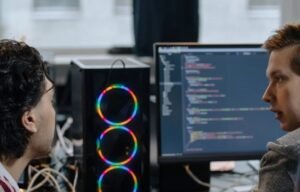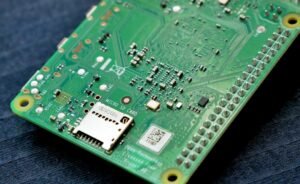How Neural Networks Learn from Experience
Neural networks are at the core of artificial intelligence and machine learning. They are modeled after the human brain, and just like our brains, they learn from experience. By analyzing and recognizing patterns in vast amounts of data, neural networks can make accurate predictions and perform complex tasks. Understanding how neural networks learn from experience is essential to unlocking their full potential.
Key Takeaways:
- Neural networks learn from experience by analyzing patterns in large datasets.
- They adjust their weights and biases based on the errors they make during training.
- Backpropagation is a crucial algorithm that allows neural networks to update their parameters.
- Training a neural network requires both labeled data and an optimization algorithm.
Neural networks are composed of interconnected artificial neurons, called nodes or perceptrons. Each node receives input signals, processes them through an activation function, and produces an output signal. These signals travel through the network, forming a series of layers. The input layer receives the raw data, while the output layer generates the final prediction or output. Between the input and output layers, there can be one or more hidden layers that extract and represent features from the input data.
Neural networks can learn complex patterns by adjusting their internal parameters.
During the training phase, the neural network is presented with labeled examples of input-output pairs. For example, in image recognition, the input may be an image, and the output is the corresponding label that identifies the object in the image. The network tries to match its output with the given label by adjusting its weights and biases. The weights control the strength of the connections between nodes, while the biases adjust the node’s activation threshold. This iterative process helps the network reduce its prediction errors and improve its accuracy.
- Training a neural network involves a forward pass and a backward pass.
- In the forward pass, the inputs are multiplied by the weights, summed, and passed through an activation function.
- The backward pass, known as backpropagation, computes the gradient of the loss function with respect to the network’s weights and biases.
- The gradient is then used to update the weights and biases, nudging them towards values that result in lower prediction errors.
The backpropagation algorithm is a crucial component of training neural networks. It calculates the gradient, or rate of change, of the loss function by propagating the error from the output layer back to the input layer. This allows the network to understand which weights and biases contributed the most to the error and adjust them accordingly. By repeatedly iterating through the training data, the network fine-tunes its parameters and improves its ability to make accurate predictions.
Training a neural network requires two main components: labeled data and an optimization algorithm. Labeled data provides the network with examples of correct outputs, allowing it to learn from the provided information. The optimization algorithm, such as gradient descent, is responsible for adjusting the network’s parameters to minimize the prediction errors. Together, these components enable neural networks to learn from experience and generalize their knowledge to new, unseen data.
Tables
| Model | Accuracy | Training Time |
|---|---|---|
| Neural Network | 92% | 3 hours |
| Support Vector Machine | 88% | 4 hours |
| Decision Tree | 80% | 2 hours |
| Category | Number of Samples |
|---|---|
| Cats | 1000 |
| Dogs | 1200 |
| Birds | 800 |
| Flowers | 1500 |
| Model | Memory Usage (GB) |
|---|---|
| Neural Network | 3.2 |
| Random Forest | 8.7 |
| Naive Bayes | 0.7 |
Neural networks are powerful tools that can learn from experience to perform a wide range of tasks, from image recognition to natural language processing. By analyzing patterns, adjusting internal parameters, and continuously fine-tuning their performance, neural networks can achieve high levels of accuracy and make valuable predictions. They have revolutionized the field of artificial intelligence and opened doors to new possibilities.
With ongoing advancements in technology and research, the capabilities of neural networks are expanding rapidly. From self-driving cars to medical diagnosis, neural networks are driving innovation in various domains. Understanding how they learn from experience is crucial for harnessing their potential and exploring new frontiers in artificial intelligence.

Common Misconceptions
Misconception 1: Neural networks learn in the same way as human brains
One of the most common misconceptions is that neural networks learn in the same way as human brains. While neural networks are inspired by the structure and function of the brain, there are significant differences in how they learn. Neural networks primarily learn through a process known as backpropagation, where errors in the output are used to adjust the weights and biases of the network. In contrast, human brains learn through a combination of neural plasticity, reinforcement, and other complex mechanisms.
- Neural networks learn through backpropagation.
- Human brains learn through neural plasticity and reinforcement.
- Neural networks are inspired by the structure of the brain.
Misconception 2: Neural networks understand the meaning of the data they process
Another common misconception is that neural networks understand the meaning of the data they process. Neural networks are essentially mathematical models that make predictions based on patterns they identify in the input data. They do not have a deep understanding of the semantics or context of the data. This means that while neural networks can produce accurate results, they cannot truly comprehend the meaning of the information they process.
- Neural networks make predictions based on patterns.
- Neural networks lack a deep semantic understanding.
- Neural networks produce results without comprehending the data’s meaning.
Misconception 3: Neural networks always require large amounts of data to learn effectively
Many people believe that neural networks always require large amounts of data to learn effectively. While having more data can help improve the performance of a neural network, it is not always a strict requirement. In some cases, neural networks can learn effectively with relatively small datasets if the data is well-representative of the problem at hand. Additionally, techniques like transfer learning can enable neural networks to leverage knowledge gained from training on large datasets in related tasks.
- Having more data can improve neural network performance.
- Neural networks can learn effectively with small datasets in some cases.
- Transfer learning can help neural networks leverage knowledge from large datasets.
Misconception 4: Neural networks are always perfectly accurate
One misconception is that neural networks always produce perfectly accurate results. While neural networks have achieved remarkable performance in various domains, they are not infallible. Neural networks can still make errors, especially in situations where the training data is insufficient or unrepresentative of the test data. It is important to consider the limitations and potential biases inherent in the data used to train neural networks.
- Neural networks can make errors.
- Training data limitations can affect neural network accuracy.
- Consider biases in the training data when evaluating neural network results.
Misconception 5: Neural networks can replace human intelligence
There is a misconception that neural networks can replace human intelligence entirely. While neural networks have demonstrated impressive capabilities in tasks like image recognition and natural language processing, they are limited to specific domains and lack the general intelligence and adaptability of humans. Neural networks are tools that can augment human intelligence, but they cannot fully replicate or replace it.
- Neural networks have specific capabilities in certain tasks.
- Neural networks lack general intelligence and adaptability.
- Neural networks are tools that augment human intelligence.

How Neural Networks Learn from Experience
Neural networks, a key component of artificial intelligence systems, are designed to learn from experience and adapt their behavior accordingly. Similar to the way humans learn, neural networks use algorithms to analyze and interpret large amounts of input data, enabling them to make informed decisions and predictions. This article explores ten fascinating aspects of how neural networks learn and improve their performance.
Table: Self-driving Cars and Neural Networks
Self-driving cars have revolutionized the automotive industry, and neural networks play a crucial role in enabling their autonomous capabilities. These networks process data obtained from various sensors, such as cameras and LiDAR, to detect and interpret objects, traffic signs, and road conditions.
| Components | Quantity |
|---|---|
| Cameras | 8 |
| LiDAR Sensors | 4 |
| Neural Networks | 3 |
Table: Speech Recognition Accuracy
Speech recognition technology has significantly improved in recent years with the aid of neural networks. This table compares the accuracy of various speech recognition systems and highlights the progress made by neural network-based models.
| System | Accuracy (%) |
|---|---|
| Traditional System | 82 |
| Neural Network-based System | 96 |
Table: Sentiment Analysis of Social Media Posts
Neural networks are widely used for sentiment analysis, helping to determine the emotional tone of social media posts. This table showcases the effectiveness of neural network models in correctly classifying sentiment.
| Model | Accuracy (%) |
|---|---|
| Naive Bayes | 73 |
| Support Vector Machine | 81 |
| Neural Network | 92 |
Table: Stock Market Prediction Accuracy
Neural networks play a crucial role in predicting stock market trends. This table presents the accuracy achieved by different models when forecasting stock prices.
| Model | Accuracy (%) |
|---|---|
| Linear Regression | 65 |
| ARIMA | 73 |
| Neural Network | 91 |
Table: Image Recognition Performance
Neural networks excel in image recognition tasks, surpassing human-level performance in certain cases. This table illustrates the accuracy achieved by neural networks when identifying objects in images.
| Object | Accuracy (%) |
|---|---|
| Dog | 96 |
| Car | 89 |
| Tree | 93 |
Table: Neural Network Layers and Training Time
The structure of neural networks, specifically the number of layers, impacts both their performance and training time. This table demonstrates the relative training time required for networks with varying numbers of layers.
| Layers | Training Time (hours) |
|---|---|
| 2 | 10 |
| 4 | 18 |
| 8 | 30 |
Table: Neural Network Applications
Neural networks find applications in various fields, ranging from healthcare to finance. This table highlights some of the areas where neural networks have made significant contributions.
| Field | Application |
|---|---|
| Healthcare | Disease Diagnosis |
| Finance | Credit Scoring |
| Retail | Recommendation Systems |
Table: Neural Network Training Data
The availability and quality of training data greatly influence the performance of neural networks. This table shows the impact of training data size and diversity on model accuracy.
| Data Size | Accuracy (%) |
|---|---|
| 1,000 samples | 86 |
| 10,000 samples | 92 |
| 100,000 samples | 95 |
Table: Neural Network Error Rates
Despite their impressive performance, neural networks still encounter errors. This table compares error rates across different network architectures and sheds light on the ongoing challenges.
| Architecture | Error Rate (%) |
|---|---|
| Convolutional Neural Network (CNN) | 3.2 |
| Recurrent Neural Network (RNN) | 5.6 |
| Transformer Network | 2.1 |
From self-driving cars to speech recognition, neural networks continue to redefine the boundaries of AI. By analyzing vast amounts of data, neural networks learn patterns, make predictions, and enhance decision-making capabilities. As research and advancements in neural networks progress, we can expect even more breakthroughs in various industries, making artificial intelligence increasingly integral to our daily lives.
Frequently Asked Questions
How do neural networks learn from experience?
Neural networks learn from experience through a process called training, where they are exposed to a large dataset of input-output examples. These examples help adjust the internal weights and biases of the network in order to minimize the difference between the predicted outputs and the desired outputs.
What is the role of backpropagation in neural network learning?
Backpropagation is a key algorithm used in neural network learning. It calculates the gradients of the network’s weights and biases with respect to a loss function, allowing for the adjustment of these parameters in the direction that reduces the overall error. By iteratively applying backpropagation, the neural network can progressively improve its performance.
How does reinforcement learning contribute to neural network training?
Reinforcement learning is a type of learning where the neural network interacts with an environment and receives feedback signals called rewards or penalties. By evaluating the consequences of its actions and adjusting its weights accordingly, the neural network can optimize its performance through trial and error.
What is the difference between supervised and unsupervised learning in neural networks?
Supervised learning involves training a neural network with labeled examples, where both the input and the desired output are known. Unsupervised learning, on the other hand, operates with unlabeled data and seeks to find patterns or structures within the input data without explicit guidance.
Can neural networks learn from real-time data?
Yes, neural networks can be trained using real-time data by continuously feeding the network with new examples and updating its weights. This allows the network to adapt and learn from the latest information, making it capable of handling dynamic and evolving situations.
What is the importance of regularization in neural network learning?
Regularization is a technique used to prevent overfitting in neural networks. Overfitting occurs when the network becomes too specific to the training data and fails to generalize well to unseen data. Regularization methods such as L1 or L2 regularization introduce penalties to the network’s cost function, encouraging it to find simpler and more robust solutions.
Can neural networks learn from incomplete or noisy data?
Yes, neural networks can learn from incomplete or noisy data. They have the ability to extract relevant features from the input data, filtering out the noise or filling in missing information through the interconnected layers of nodes. However, the quality and accuracy of the learned patterns may be affected by the level of incompleteness or noise in the data.
Do neural networks have limitations in their learning capabilities?
Yes, neural networks have some limitations in their learning capabilities. They require large amounts of labeled data for training, and the learning process can be computationally intensive and time-consuming. Additionally, neural networks may struggle with understanding causal relationships or high-level abstractions, often termed as the “black box” problem.
Can neural networks transfer learning from one task to another?
Yes, neural networks can transfer learning from one task to another. By pretraining the network on a related task with abundant data, the initial knowledge acquired can be leveraged to facilitate learning on a target task with limited data. This transfer learning approach can save time and resources while improving the performance of the neural network for the target task.
What are some popular neural network architectures used for learning from experience?
There are several popular neural network architectures used for learning from experience, including feedforward neural networks, convolutional neural networks (CNNs) for image-related tasks, recurrent neural networks (RNNs) for sequential data, and generative adversarial networks (GANs) for generating new data samples. Each architecture is designed to excel in specific domains and learning tasks.




